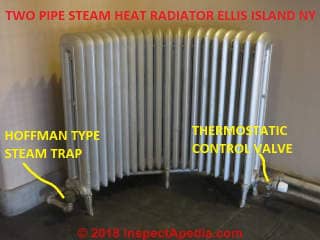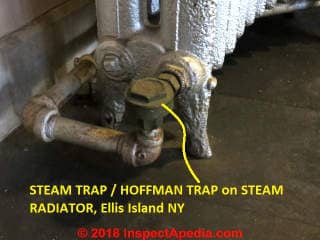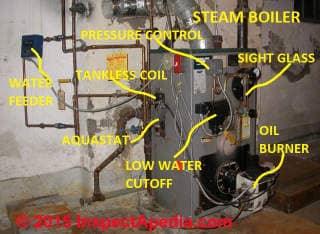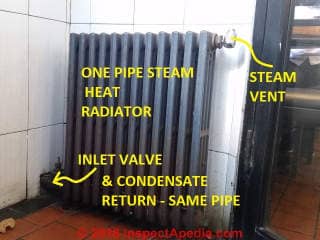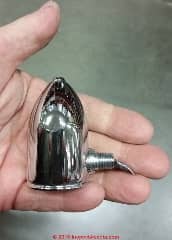 Steam Trap FAQS
Steam Trap FAQS
Q&A on identification, use, repair of steam traps
- POST a QUESTION or COMMENT about radiator steam trap function, installation, repair or replacement: Hoffman steam traps and similar devices
FAQs on steam trap types, applications, & locations.
Here we explain how to reognize a steam trap and we wax eloquent on how steam radiator traps are different from steam vents.
This article series explains the purpose and function of steam traps use on steam piping systems at the radiator, in the steam piping system, and on the steam mains.
Page top sketch: thermostatic operated steam traps, courtesy of Carson Dunlop Associates a Toronto home inspection, report writing, and education company.
InspectAPedia tolerates no conflicts of interest. We have no relationship with advertisers, products, or services discussed at this website.
Steam Traps: types, locations, identification, troubleshooting, replacement
 These questions and answers about steam traps were posted originally at STEAM TRAPS - please be sure to review that article where we describe the types of traps and their uses, repair, and maintenance.
These questions and answers about steam traps were posted originally at STEAM TRAPS - please be sure to review that article where we describe the types of traps and their uses, repair, and maintenance.
[Click to enlarge any image]
Question: how does a two pipe steam radiatior work if there is no steam vent?
My brother-in-law says all steam heating system radiators have to have a steam vent that lets air out of the radiator or the radiator won't get hot.
But looking at my radiators I can't find any steam vents.
What's going on, and what do I do if some of the radiators won't get hot even when my boiler is running and my thermostat is calling for heat?
- Cold in Altoona 2018/12/10
Reply: two pipe steam systems using steam traps don't need steam radiator vents
Altoona:
If there are no steam vents on your steam heat radiators don't despair: your steam heat is probably a two-pipe steam heating system that uses steam traps.
"Two pipe" radiators means that each heating radiator will have two pipes connected to it: one is a source of heat (steam in this case) fed into the radiator, and the second is a condensate return line that allows water produced by cooling steam to return to the boiler.
Above my photo shows a lovely curved two pipe steam radiator installed at Ellis Island, New York.
A thermoststatic control valve at the radiator's right end (white knob) controls the steam input into the radiator - closeup below:
and a Hoffman steam trap at the radiator's left end allows condensate to return to the steam boiler - shown below - possibly through a condensate pump somewhere as this Ellis Island immigration center was an enormous building.
Steam will be fed into the radiator at the top or bottom of one end of the radiator. In a two pipe steam heat system condensate returns out of the other end of the radiator.
In a one pipe steam heating system the condensate has to find its way back to the boiler through the same single heating pipe.
In my photo above the steam input is connected at the top right of the steam radiator and the condensate return, through a steam trap, is found at the lower left end of the same radiator.
A steam trap is found at the lower or outlet end of a two pipe steam radiator heat system where it works to keep hot steam in the radiator but lets steam condensate (water ) flow back down the return pipe so that it can return to the steam boiler.
Here is how you can figure out that your building uses steam heat, and here is how you can further identify steam radiators in comparison with hot water radiators.
- Take a look at the heating boiler to confirm that it's a steam boiler,
not a hot water or hydronic heating system (hot water heat).
You can recognize a steam boiler easily: look for the [Click to enlarge any image]
SIGHT GLASS, STEAM BOILER
LOW WATER CUTOFF VALVE, BOILER
PRESSURE CONTROL, STEAM BOILERS
WATER FEEDER VALVE, STEAM
Any or all of these controls - found at or attached to the boiler, will help you recognize a steam boiler - Look to see if a hot water radiator is in use on a low level in a steam heat building -
the radiator may be using hot water not steam.
Some steam heating systems may include a hot water or hydronic heat using hot water radiators not steam radiators on the lower floor or basement level when all of those radiators are located below the water level in the steam boiler. - How to recognize a Steam Trap:
Depending on the application steam traps are sold in a blizzard of forms and features but they'll geneally look like a "canister" type device like the one shown below. A steam trap is most-often found at the bottom of a steam radiator at the end opposite the inlet valve.
Steam traps, like the one shown above, are found at one end of a steam radiator where they allow condensate to return to the boiler while keeping steam in the radiator.
From the appearance of its cap with that rounded dot I suspect this is a Watts-brand thermostatic radiator steam trap.
Steam traps can be pretty sophisticated.
The Watts series G, GH, MG and MGH thermostatic radiator steam traps can remove condensate (sending it back to the boiler) and they also remove air and non-condensate gases from the steam heating system while being sensitive enough to close in the presence of steam - thus assuring that the heat energy of the steam is used to heat the radiator.
How does the steam trap work: well designs vary, but using the Watts series G etc. steam traps I just named, here is how the company describes the operation of this radiator steam trap:
The Series G, GH, MG, MGH's Balanced Pressure-Duplex
Phosphor Diaphragm is a highly sensitive modulation unit
thermally programmed to provide accurate steam conserving
operation at all pressure temperature points within its range
of operation.
A special liquid, hermetically vacuum-sealed, is employed in a
unique duplex design.
The volatile characteristics of this liquid,
with a lower boiling point than that of water, create a higher
internal pressure for a given steam temperature.
This
pressure/temperature relationship causes the duplex diaphragm
to expand uniformly, closing the orifice opening in a replaceable
stainless steel seat with a self-centering corrosion-resistant and
hardened stainless steel diaphragm valve.
In the presence of
lower temperature condensate and/or non-condensate gases,
the stainless steel valve is withdrawn by the internal condensing
of the duplex diaphragm liquid, allowing full discharge of any
condensate of noncondensables.
The diaphragm quickly recycles
closed in the presence of steam.
Source: WATTS SERIES G GH MG MGH THERMOSTATIC RADIATOR STEAM TRAPS [PDF] (2004), Watts Regulator Co., USA: 815 Chestnut St., No. Andover, MA 01845-6098; www.wattsreg.com or Canada: 5435 North Service Rd., Burlington, ONT. L7L 5H7; www.wattscda.com
You won't hear hissing and you won't find a "steam vent" on a steam radiator that uses a steam trap.
See STEAM TRAPS - for details about these devices.
Also see
- Carey, George, TWO PIPE STEAM SYTSEM & NO TRAPS [PDF] retrieved 2018/12/11, original source: https://www.fiainc.com/sites/default/files/Two%20pipe%20steam%20system%20and%20no%20traps.pdf
- Gulotta, Matthewe, Alexander Collins, METHODS FOR CONTROLLING ONE AND TWO PIPE SYSTEMS FOR COMFORT, EVEN TEMPERATURE DISTRIBUTION AND ENERGY SAVINGS. or Living with a Steam Heating System, a Guide for New Yorkers (but not engineers) [PDF] retrieved 2018/12/11, original source: https://www.pacollinspe.com/wp-content/uploads/Steam_PACPE.pdf
Above: a one pipe steam heating system radiator with its steam vent at the upper right end of the radiator - installed in an apartment in Brooklyn, NY.
- How to recognize a Steam Vent: unlike steam traps, steam vents, also referred to as air valves, open to release air out of the radiator as steam begins to enter.
Steam vents are be used on 1 pipe steam heating systems. The vent, controlled by a float or by temperature alone (thermostatic air vents) releases air to allow steam into the radiator - otherwise the radiator will not heat up.
As steam is rising in the heating system pipes (in response to a thermostat calling for heat), the steam vent will hiss as it releases air until the temperature in the radiator at the vent is high enough to close the vent.
See STEAM VENTS are described separately and are used on one pipe steam heating systems and on some two-pipe steam heating systems.
Below: a Durst / Maid o Mist air vent or steam radiator valve, model #40. This is a float type vent
If your steam radiator won't get hot
As ITT/Hoffman and all other steam vent manufacturers will tell you:
A cold upper part of the radiator may indicate the vent is plugged with scale or is malfunctioning.
See COLD STEAM HEAT RADIATORS for diagnostic and repair suggestions.
Question: what is "too hot" for steam radiators: "F" or "T" steam traps?
(Feb 3, 2015) Timothy said:
What is too hot for steam radiators or F & T traps?
Thanks in advance.
Reply:
Timothy I don't quite understand the question.
Steam heating systems, at least in residential or occupied-space heating, operate at low pressure and won't and can't exceed steam temperatures leaving the boiler.
Since steam temperature is directly a function of the pressure in the system, if we're talking about a conventional steam heating system operating at say 0.5 psi or below,
E.g.
at 0 psi (sea level or one atmosphere which is about 14.7 psi) the steam temperature will be the boiling temperature of water = 212degF or 100 C (ignoring the impact of any boiler additive chemicals on its boiling point)
at 1 psig (which is DOUBLE the usual operating pressure of a low pressure steam heating system) the boiler pressure will be at 1 psig and the absolute pressure would be atmospheric + 1 psi = 15.7 psi: the steam temperature would then be at 215.5 degF or 101.9 C.
Comment: For mainline applications, thermodynamic steam traps are always better
July 20, 2015)
Mandar Karanjkar said:
For mainline applications, thermodynamic steam traps are always better than others.
Whereas, on process equipment, float type traps perform the best. Inverted bucket traps or bucket traps have poor air venting capacity but are great to resist water hammer. You can get some useful information about steam traps over here
...
Continue reading at STEAM TRAPS or select a topic from the closely-related articles below, or see the complete ARTICLE INDEX.
Or see these
Steam Heat & Steam Trap Articles
- STEAM HEATING SYSTEMS & CONTROLS - home
- CHECK VALVES, HEATING SYSTEM
- COLD STEAM HEAT RADIATORS
- CONDENSATE RETURN PIPES, PUMPS, STEAM
- HARTFORD LOOP
- LOW WATER CUTOFF VALVE
- SIGHT GLASS, STEAM BOILER
- STEAM TRAPS
- STEAM VENTS - home
Suggested citation for this web page
STEAM TRAP FAQs at InspectApedia.com - online encyclopedia of building & environmental inspection, testing, diagnosis, repair, & problem prevention advice.
Or see this
INDEX to RELATED ARTICLES: ARTICLE INDEX to STEAM BOILERS
Or use the SEARCH BOX found below to Ask a Question or Search InspectApedia
Ask a Question or Search InspectApedia
Questions & answers or comments about radiator steam trap function, installation, repair or replacement: Hoffman steam traps and similar devices .
Try the search box just below, or if you prefer, post a question or comment in the Comments box below and we will respond promptly.
Search the InspectApedia website
Note: appearance of your Comment below may be delayed: if your comment contains an image, photograph, web link, or text that looks to the software as if it might be a web link, your posting will appear after it has been approved by a moderator. Apologies for the delay.
Only one image can be added per comment but you can post as many comments, and therefore images, as you like.
You will not receive a notification when a response to your question has been posted.
Please bookmark this page to make it easy for you to check back for our response.
Our Comment Box is provided by Countable Web Productions countable.ca
Citations & References
In addition to any citations in the article above, a full list is available on request.
- In addition to citations & references found in this article, see the research citations given at the end of the related articles found at our suggested
CONTINUE READING or RECOMMENDED ARTICLES.
- Carson, Dunlop & Associates Ltd., 120 Carlton Street Suite 407, Toronto ON M5A 4K2. Tel: (416) 964-9415 1-800-268-7070 Email: info@carsondunlop.com. Alan Carson is a past president of ASHI, the American Society of Home Inspectors.
Thanks to Alan Carson and Bob Dunlop, for permission for InspectAPedia to use text excerpts from The HOME REFERENCE BOOK - the Encyclopedia of Homes and to use illustrations from The ILLUSTRATED HOME .
Carson Dunlop Associates provides extensive home inspection education and report writing material. In gratitude we provide links to tsome Carson Dunlop Associates products and services.


